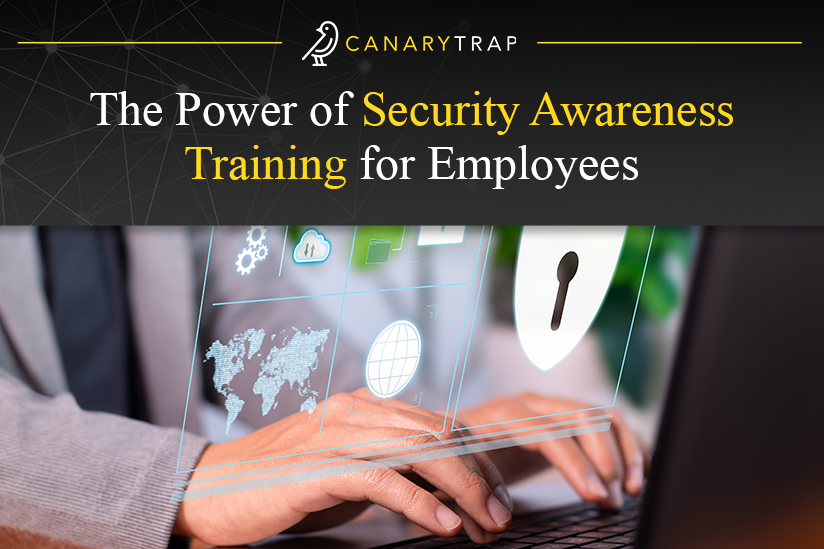The Power of Security Awareness Training for Employees
- August 2, 2024
- Canary Trap
In today’s digital landscape, cybersecurity has become a paramount concern for businesses of all sizes. With cyber threats evolving and becoming more sophisticated, it is essential for organizations to implement comprehensive security measures. One of the most effective strategies to enhance cybersecurity is through security awareness training for employees. This training equips staff with the knowledge and skills to identify and respond to potential threats, transforming them into the first line of defense against cyberattacks.
Security awareness training is not just about protecting the organization’s assets; it’s about fostering a culture of security. When employees understand the importance of cybersecurity and are aware of their role in maintaining it, they are more likely to adopt secure practices in their daily activities. This proactive approach helps to prevent data breaches, reduce the risk of human error, and ensure compliance with data protection regulations.
In this blog, we will delve into the key elements of effective security awareness training, its importance, the role of leadership, and the psychological aspects that influence security behavior. We will also explore how security practices extend beyond the workplace and will take a look at future trends in security awareness training. By prioritizing security awareness training for employees, organizations can create a robust defense against cyber threats and ensure a secure operating environment.
Key Elements of Effective Security Awareness Training
As it was explained in an article published by Meta Compliance, “The success of your security awareness program depends upon understanding the types and volumes of threats and how the various stages of scams and cyber attacks work. The threat landscape changes quickly, so it is important to stay on top of cybercriminal activities.” Creating an effective security awareness training program involves several key elements to ensure it is comprehensive and engaging for employees.
- Regular and Updated Training Sessions
Cyber threats are constantly evolving, so training sessions must be conducted regularly and the content updated frequently. This ensures that employees are aware of the latest threats and how to handle them.
- Interactive and Engaging Training Methods
Using interactive methods such as simulations, quizzes, and real-world scenarios can significantly enhance the learning experience. These methods help employees better understand the material and apply it in real situations.
- Customizing Training to Address Specific Threats
Tailoring the training program to address specific threats relevant to the organization’s industry and operations makes it more effective. Customization ensures that employees are prepared to handle the unique challenges they may face in their roles.
At Canary Trap we cannot overstate the importance of incorporating these elements into the security awareness training programs of organizations, so that they can effectively educate their employees, reduce the risk of security incidents, and strengthen their overall security posture.
The Importance of Security Awareness Training
Security awareness training is vital for any organization aiming to protect its digital assets and maintain a strong security posture. The benefits of training employees on cybersecurity are numerous, ranging from reducing the risk of data breaches to fostering a culture of security within the organization.
Dan Sharp, President and CEO of Infoware, explains that “under comprehensive cybersecurity awareness training, employees are better equipped to follow best practices, adhere to security policies, and contribute to a safer working environment. Moreover, a well-informed workforce can advocate for and reinforce a culture of security where safe behaviors become the norm rather than the exception.”
Let’s delve deeper into some of the benefits of training employees on cybersecurity:
- Reduction in Security Incidents
By educating employees about the various types of cyber threats and how to recognize them, organizations can significantly reduce the number of security incidents. Trained employees are less likely to fall for phishing scams, click on malicious links, or inadvertently expose sensitive information.
- Cost Savings
Preventing security breaches can save organizations substantial amounts of money. The costs associated with data breaches, including fines, legal fees, and reputational damage, can be astronomical. Investing in security awareness training is a cost-effective way to mitigate these risks.
- Enhanced Compliance
Many data protection regulations, such as GDPR and CCPA, require organizations to implement security awareness training for their employees. By ensuring compliance with these regulations, organizations can avoid hefty fines and legal consequences.
Several recent high-profile data breaches have highlighted the consequences of inadequate employee awareness. For example, in January 2023, T-Mobile suffered a data breach that exposed the personal information of 37 million customers due to a flaw in one of its APIs exploited by hackers. Another significant breach occurred in June 2023 when the PharMerica network was attacked by the Money Message ransomware group, compromising the personal and medical information of over 6 million patients.
By understanding the importance of security awareness training and its impact on reducing cyber threats, organizations can take proactive steps to protect their data and maintain a secure operating environment.
The Role of Leadership in Security Awareness
Leadership plays a crucial role in fostering a culture of security within an organization. When leaders prioritize and actively participate in security awareness initiatives, it sets a positive example for employees and underscores the importance of cybersecurity.
In an article published by Complete Network, it’s mentioned that “traditionally, IT security was seen as a technical issue to be managed by the IT department and the IT department only. However, the evolving threat landscape has changed this perspective. Now, the key is bridging the gap between a company’s IT and executive leadership teams. Cyber attacks can have devastating effects on an entire organization, including financial losses, reputational damage, and regulatory penalties. These risks underscore the need for a holistic approach to IT security, one that involves the entire organization, starting with its leadership.”
Importance of Leadership Involvement
- Setting the Tone
Leaders who emphasize the significance of cybersecurity create an environment where employees feel responsible for protecting organizational assets. This top-down approach ensures that security awareness becomes a core part of the company culture.
- Resource Allocation
Effective security awareness training requires investment in time, tools, and personnel. Leadership commitment ensures that adequate resources are allocated to develop and maintain robust training programs.
- Motivating Employees
When leaders are visibly engaged in security initiatives, it motivates employees to take the training seriously. Regular communication from leadership about the importance of cybersecurity can reinforce the message and encourage proactive behavior.
Strategies for Leaders
- Lead by Example
Leaders should participate in training sessions and follow the same security protocols expected of employees. This demonstrates commitment and sets a standard for the rest of the organization.
- Communicate Regularly
Frequent updates and reminders about cybersecurity from leadership can keep the topic top-of-mind for employees. This can be done through emails, meetings, and internal newsletters.
- Recognize and Reward
Acknowledging employees who demonstrate strong security practices can reinforce positive behavior. Rewards and recognition programs can incentivize adherence to security protocols.
Creating a security-conscious culture in an organization needs the active involvement by leadership in security awareness training, so that they can create a culture that empowers employees to take an active role in protecting digital assets.
Security Awareness Beyond the Workplace
Security awareness shouldn’t be confined to the workplace; extending cybersecurity practices to employees’ personal lives is equally important. By promoting a holistic approach to security, organizations can enhance overall cybersecurity resilience.
In an article about security awareness training recommendations by CybSafe, they highlight that “security awareness training doesn’t just keep people safe at work. It keeps them safe from cybersecurity threats, phishing threats, and social engineering in their personal life, too. Effective cybersecurity awareness training delivers threat prevention tools to people, not simply an organization. That means it isn’t just an employer benefit. It’s also an employee benefit.”
Extending Cybersecurity Practices
- Personal Device Security
Educating employees about securing their personal devices can prevent potential vulnerabilities. This includes using strong passwords, enabling two-factor authentication, and regularly updating software.
- Safe Online Behavior
Encouraging safe online practices, such as recognizing phishing attempts and avoiding suspicious links, helps employees protect their personal information and reduces the risk of compromising organizational data.
- Social Media Awareness
Training on the risks associated with oversharing on social media and how to manage privacy settings can prevent personal and professional information from being exploited by cybercriminals.
Benefits of a Holistic Approach
- Increased Vigilance
Employees who practice good cybersecurity habits at home are more likely to carry these practices into the workplace, enhancing overall security.
- Reduced Risk
By safeguarding personal devices and information, employees reduce the chances of cyber threats spilling over into their professional environment.
- Empowerment
Educating employees on personal cybersecurity empowers them to take control of their digital lives, fostering a culture of security awareness that benefits both the individual and the organization.
By extending security awareness beyond the workplace, organizations can create a more robust and comprehensive cybersecurity strategy.
The Future of Security Awareness Training
The landscape of security awareness training is evolving, driven by emerging trends and advancements in technology. Understanding these developments can help organizations stay ahead of cyber threats and ensure their training programs remain effective.
Emerging Trends and Technologies
- Artificial Intelligence (AI) and Machine Learning (ML)
AI and ML are increasingly being integrated into security awareness training programs. These technologies can analyze patterns in employee behavior to identify vulnerabilities and tailor training content to address specific weaknesses. AI-driven simulations can create realistic threat scenarios, enhancing the training experience and improving employee response to real-world attacks.
- Gamification
Incorporating gamification into training programs can make learning about cybersecurity more engaging. Using game-like elements such as points, badges, and leaderboards can motivate employees to participate actively and retain information better. Gamification can transform routine training sessions into interactive and enjoyable experiences.
- Virtual Reality (VR) and Augmented Reality (AR)
VR and AR technologies offer immersive training experiences that simulate real-world cybersecurity scenarios. These tools can help employees practice responding to threats in a controlled, virtual environment, improving their preparedness for actual incidents.
Predictions for the Evolution of Security Awareness Programs
- Personalized Training
The future of security awareness training lies in personalization. AI and ML will enable programs to adapt to individual learning styles and threat profiles, providing customized content that maximizes effectiveness.
- Continuous Learning
Security awareness training will shift towards continuous learning models, with ongoing education and regular updates to keep pace with evolving threats. Microlearning modules and just-in-time training will become more prevalent, offering bite-sized, relevant information when employees need it most.
Embracing these emerging trends and technologies is the best way for organizations to enhance their security awareness training programs, making them more dynamic, personalized, and effective in preparing employees to combat evolving cyber threats.
In Conclusion
Security awareness training is a fundamental component of an organization’s cybersecurity strategy. By educating employees on recognizing and responding to cyber threats, businesses can significantly reduce the risk of data breaches and other security incidents. Effective training encompasses regular updates, interactive methods, and customization to address specific threats, ensuring that employees are well-prepared.
Leadership plays a crucial role in fostering a culture of security, motivating employees, and ensuring adequate resources for training programs. Extending security practices beyond the workplace and addressing the psychological aspects of security further strengthen an organization’s defenses.
Looking ahead, emerging technologies such as AI, VR, and gamification promise to revolutionize security awareness training, making it more personalized and engaging. By prioritizing continuous education and leveraging these advancements, organizations can stay ahead of evolving cyber threats and ensure a secure operating environment.
Investing in comprehensive security awareness training not only protects digital assets but also fosters a culture of vigilance and responsibility, crucial for long-term success in the digital age.
SOURCES:
- https://www.metacompliance.com/blog/cyber-security-awareness/elements-successful-security-awareness-training
- https://www.infoware.ca/blog/benefits-of-security-awareness-training
- https://www.hrmagazine.co.uk/content/news/employee-data-breaches-hit-five-year-high
- https://complete.network/the-role-of-leadership-in-security/
- https://www.cybsafe.com/blog/7-reasons-why-security-awareness-training-is-important/#mega-menu-primary-menu

